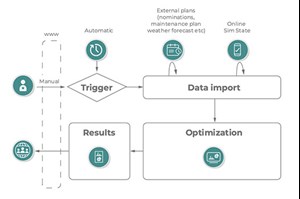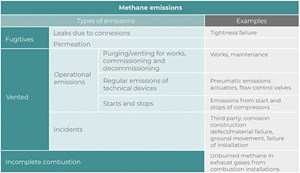Articles
High-quality, low-risk energy transition to hydrogen
Special Focus: Hydrogen Infrastructure Development
J. ANDERTON, Atmos International, Manchester, UK
While the move to hydrogen (H2) and other renewable natural gases has accelerated the pipeline industry’s transition to cleaner energy, it has also exposed the challenges that come with operating a H2 pipeline.
Managing the energy transition to H2 requires considering the complex impact H2 can have on any pipeline network. For example, are pipeline staff able to reskill quickly enough to operate a pipeline transporting H2 blends? Can security of supply be maintained while also accommodating changes in demand? How can leak detection be increasingly prioritized on a pipeline that can now leak product more easily due to the size of H2 molecules?1
Pipeline operators should prioritize and ask a range of questions as they manage a pipeline’s transition to H2—the author’s company’s simulation softwarea can answer these questions. Some of the key challenges facing the energy transition to H2 and how simulation software can help are discussed here.
Are pipeline operators prepared for greener fuel operations? At the moment, operators are typically only familiar with what happens in their natural gas pipelines—transporting high concentrations of H2 requires a different approach. Once high concentrations of H2 are added, past experience working on a natural gas pipeline is no longer sufficient.
For example, particular attention must be paid to pressure and temperature levels in a H2 pipeline. Failure to do so can cause pipelines to go brittle (fractures in the pipeline), which can not only affect pipeline capacity but can cause leaks, shrinkage or unaccounted gas.
To accelerate the training of pipeline operators and controllers for managing batches of H2 fuel, simulation software is equipped with modules that can act as an informed advisor (FIG. 1).

After receiving the pipeline operator’s nominations and maintenance schedule, the softwarea can make recommendations about how to run the pipeline network to maximize profit and minimize cost while meeting the demands of the end client. This kind of modern simulation software uses machine-learning so simulated models of H2 pipelines can also be continuously optimized.
Visibility, understanding and control of H2 fuel data. On a pipeline that is not operating a simulation software, flow, pressure and temperature meters are typically set up at supply and delivery points, with pressure and temperature meters at compressor and valve stations. However, there is often no measurement between the stations due to the cost of instrumentation or because certain pipeline sections are buried or in a remote location without power and communications.
When a relatively new fuel like H2 is introduced to a pipeline that already has blind spots in its data, a greater risk of discrepencies exists between the pipeline’s inlet and outlet. As previously mentioned, careful attention must be paid to flow, pressure and temperature on a pipeline containing H2 because its properties differ to natural gases.
By using the available data at the pipeline’s supply and delivery points, simulation software can use supervisory control and data acquisition (SCADA) measurements to create a “digital twin” that provides visibility of not only the flow, pressure and temperature, but also the velocity and gas composition along the whole pipeline, including the originally unmetered, intermediate points. For a pipeline network beginning to introduce H2 blends, the simulation software’sa ability to make a digital twin of a pipeline’s operations is fundamental to the successful transition to carbon-neutral fuels and provides the required visibility, understanding and control of H2 fuel data.
For example, Norwegian pipeline operator Gassco’s network is located under the North Sea. The company uses a proprietary simulation suitea to fill in the metering gaps so it has reliable and accurate calculations throughout the whole subsea network, as shown in FIG. 2.
Because blends of H2 and natural gas will vary, batches must be accurately modeled from 0% H2–100% H2; the challenge here is that older equations of state available in some pipeline simulation software are not equipped to handle H2 blends. Using modern equations that factor in fuel blends can ensure that calculations involving H2 are accurate.
Managing the reduction of venting and leakage. Although H2 is a cleaner source of energy, if the fuel leaks into the atmosphere, its methane emissions contribute to climate change (FIG. 3). As mentioned previously, H2’s small molecular weight makes it difficult to contain and increases the risk of venting and leakage. In its first 5 yr of replacing fossil fuels, a high-leakage scenario for H2 could cause nearly double the amount of global warming caused by fossil fuels.2

As shown in FIG. 3, gas venting—the controlled release of gas into the Earth’s atmosphere—is a leading source of methane emissions; this can be a result of incidents outside the pipeline. To improve network operations, hardware and non-intrusive instrumentation can be retrofitted to pipelines to provide fast and accurate leak detection, which simulation software can use to locate leaks and minimize or avoid gas venting.
To minimize and avoid gas venting on a pipeline transporting H2, the proprietary simulation softwarea can use nominations look-ahead modeling to support on an operational level and ensure bookable capacity is never overestimated or underestimated.3 The look-ahead facility available to simulation software can also forecast survival time when a loss of supply is apparent on the pipeline and provide a projection of future pressure when there has been a compressor station shutdown.
Simulation software simplifies the transition to cleaner fuel transportation. Reskilling pipeline staff in the operations of a H2 pipeline, understanding and controlling H2 fuel data, and managing the reduction of venting and leakage are just some of the challenges that pipeline operators will face as they introduce H2 blends into their pipelines.
To minimize interruptions to the pipeline network, using a simulation softwarea like that of the author’s company can ease the transition to H2.H2T
NOTES
a Atmos Simulation (SIM) Suite
LITERATURE CITED
1 “Different ways to reduce greenhouse gas emission in pipelines,” Atmos International, online: https://www.atmosi.com/en/resources/technical-papers/different-ways-to-reduce-greenhouse-gas-emission-in-pipelines/
2 Environmental Defense Fund, “For hydrogen to be a climate solution, leaks must be tackled,” online: https://www.edf.org/blog/2022/03/07/hydrogen-climate-solution-leaks-must-be-tackled
3 Metwall, M., J. Modisette, A. Hoffman and J. Zhang, The Atmos book of pipeline simulation, Atmos Intl. LTD., February 16, 2022.
About the author

JOHN ANDERTON has spent more than 20 yr working with pipeline simulation in varying roles from project delivery to product management, including 2 yr working for a major gas transportation company in Australia as a business analyst. He specializes in offline and online simulation for the oil and gas industry and has worked with many major operators worldwide. In his current role, Anderton provides internal and external consultancy to ensure client requirements and Atmos solutions are aligned, and that Atmos maintains its position as a world leader in simulation solutions.


